Michaela Coel isn’t buying anything new next month. Are you? | Television & radio
Michaela Coel could be wearing anything she wanted, right now. As the star and creator of I May Destroy You, the BBC drama that became a water cooler hit even in a summer without water coolers, Coel is the hottest property in town. Any fashion designer would jump at the chance to dress her. But today she is enthusing over a time-pummelled black sweatshirt with faded insignia, sourced not from a Bond Street boutique but from Oxfam’s cavernous warehouse in Batley, North Yorkshire. “I’m here for it,” she murmurs approvingly, pulling it over her head.
She’s here for all of it. She’s here for the pale pink Burberry trenchcoat, another Batley treasure unearthed for our shoot by Oxfam’s senior fashion adviser, Bay Garnett, a nod to Coel’s neon bubblegum bob as Arabella in IMDY. She’s here for the dynamite 80s jeans and matching jacket in toffee-apple faux-leather, a rare Gaultier Jeans find. She’s here for the Fanta-coloured boilersuit (think Ripley in Alien meets Bananarama on Top Of The Pops), for the elegant 70s Jaeger mustard blazer with anchor-stamped gold buttons, and for a knockout pair of Versace high-waisted shorts, illustrated with classic Rita Hayworth film posters.
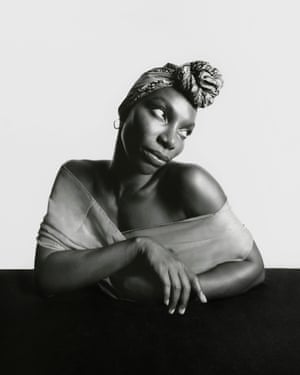
Coel has a distinctive, three-tiered expression, when she is introduced to someone new. Instantly recognisable from screen, it is even more mesmerising in real life. She opens her eyes extra wide, drops her mouth slightly open for a moment, the high planes of her cheekbones catching the light, before veering into a mile-wide smile. The combination of split-second comic timing and diamond-cut bone structure is dynamite, and Coel has the whole studio transfixed. Ahead of our shoot, she has asked not to be interviewed about her work, because she is feeling talked-out on the subject. Instead she is here to lend her star power to a cause, as the face of Second Hand September, an Oxfam campaign to encourage people to pledge not to buy new clothes for the entire month.
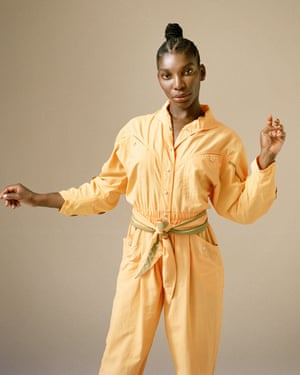
Think of it as dry January for clothes addicts. Oxfam hopes that the campaign, now in its second year, will establish itself on the calendar in the same way. In normal times, September is the month when summer dresses are packed away, and the trend cycle reboots – hence those hefty September issues of the glossy magazines, full of new-look wishlists. Second Hand September takes this principle of the wardrobe reset and reframes it, challenging consumers to find new looks with old clothes instead. Last year 62,000 people, including Vivienne Westwood, Rachel Weisz and Paloma Faith all signed up.
Coel has long taken an independent approach to fashion, wearing a dress made with Ghanaian kente cloth for her first red carpet moment, the 2016 Baftas. (She won two of the three categories in which she was nominated for her breakout series, Chewing Gum.) So when she was approached by Oxfam, Coel says, she “felt compelled to add my voice to this cause. I hope it raises awareness and encourages us to reflect on our buying habits. Small changes can have a huge impact on the environment – and, in turn, the fight against poverty.”
On set, Coel’s phone blasts out an eclectic mix of music. Sixties soul singer Barbara Lewis pops up in between new tracks by Californian band Thee Sinseers and female British rap artist Lex Amor. The clothes Garnett has chosen, likewise, are cool and contemporary, even when they are decades old. “Nothing looks more contemporary than great thrift stuff,” Garnett explains. “When you get it right, it doesn’t look retro at all.”
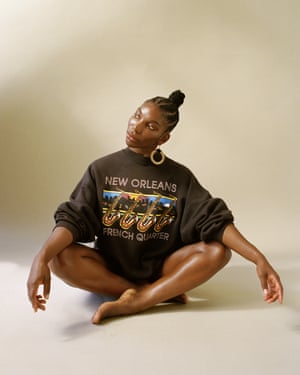
The clothes on the rail today are taken from 1,500 pieces she handpicked to stock an Oxfam “luxury pop-up” at Selfridges in London, which opens on 7 September. “I’ve got a brilliant flying jacket. I’ve got a print that could be Prada. I’ve got three great Ossie Clarke dresses and an incredible 1970s sequin gown with a tiger at the hem. But with Oxfam price tags.” In a premium space on the second floor – slap bang next to Prada, Celine and Balenciaga – the shop will be “almost like a fake luxury store,” says Garnett, “with all the bells and whistles of that space. Marble, velvet, lots of room.” (Selfridges is funding the fit-out.) “Look, first of all, it’s fun,” she says. “I’m not here to lecture anybody. But I do sort of hope people do a double-take.”
Garnett has championed secondhand clothes as high-fashion catnip all through her 20-year styling career. For the May 2003 edition of British Vogue, she put Kate Moss in a banana-print leotard top and white denim shorts, both thrift store discoveries. Her friend Phoebe Philo, then designer at Chloé, saw the magazine, called and asked to borrow the top, and the look became the inspiration for Chloé’s spring 2004 collection – followed by most of the British high street.
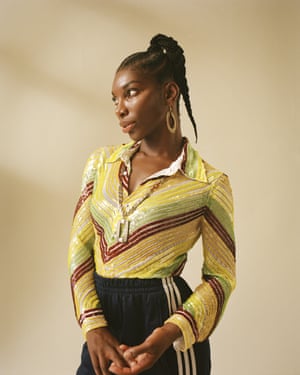
When she worked at Vogue, the then editor, Alexandra Shulman, used to tell Garnett that she had a knack for making designer clothes look as if they came from a charity shop. Garnett recounts this as if it were a prized compliment; to her, secondhand is always best. She pulls out herringbone tweed coats to enthuse about the linings, turns silk blouses inside out to coo over the seams.
“Secondhand has always felt to me like a more empowering way to shop,” she says. “I like that I’m opting out of the system a bit. I love fashion but I want to do it my way, without being dictated to by big brands with all the money and marketing power.” In her Oxfam role, she adds, it feels “empowering in a more urgent way than ever, because it is tied up with the environment and with clothes being sold to raise funds to help the poorest people in the world. I love the idea of old clothes being that powerful.”
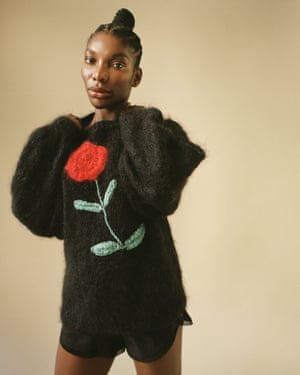
Coel would agree, and worked with costume designer Lynsey Moore on the wardrobe for both Chewing Gum and I May Destroy You with a similar principle in mind. “Right from the start, Michaela knew she wanted to use as much secondhand and sustainable clothing as possible,” Moore says. “That suited me because most of my own clothes are from charity shops and vintage stores. Vintage clothes have the best stories.”
Moore trawled Rokit and Beyond Retro, and hunted down pre-loved high street pieces on eBay. “My aim for [Coel’s character] Arabella was always that I didn’t want her to look like anyone else. There was no prior reference for her style. Arabella is a total original and her clothes needed to reflect that. And I felt like she and her friends were the kind of people you would meet vintage shopping in Brick Lane, so I went with that.”
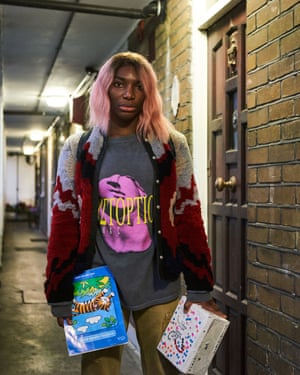
The fixed point of Arabella’s look was the pink wig, which appeared in the original script. “So I looked out for pink and purple pieces that would tie into that,” says Moore, “to make it feel like the clothes are part of her.” The bold, graphic print cardigan which Arabella wears for her powerful take-down of Zain at the writers’ summit came from Moore’s own wardrobe, bought from a vintage store in London’s Soho. “We could have gone with something more obviously authoritative, but this was more Arabella,” says Moore. She and Coel added shoulder pads to the cardigan for a more powerful silhouette.
The current trophy piece in Moore’s own wardrobe is a black denim jacket with collar and pockets intricately embroidered with pearls. “I won it on eBay for £2.50 and I’m obsessed with it. Charity shopping on eBay – that’s my Sunday night treat,” she says. “Designer labels matter if you are looking for resale value, but I shop secondhand by looking at colour and fabric.” She recommends taking a friend with you, “because this is an activity, not just a purchase. It should be fun! Oh, and take a tape measure. If you know your waist measurement, you can see instantly if a pair of trousers will fit you. Saves a lot of time.” If you don’t know where to start, Moore’s tip is to look out for silk shirts: “A good silk blouse in a great colour or print will never let you down. You can wear it tucked into jeans, or layered under a jumper, or loose over a bikini – in 15 years’ time, you’ll still be wearing it.”
On set, Coel has pounced on a rose-embroidered mohair sweater with this season’s puff sleeves. It is quirky, but also very now – a lot like her, in fact. And the pandemic has made Coel’s cheerleading for Second Hand September even more urgent. The closure of 600 stores, and the cancellation of major fundraising events including the London marathon and Glastonbury, saw Oxfam lose £5m per month during lockdown. This is dire, at a moment when a global economic downturn threatens the welfare of the world’s poorest and most vulnerable. If there is to be a silver lining, it is in the possibility of a post-lockdown reset, as consumers decide not to return to the bad old ways of overconsumption.
Every September, the world is looking for a fresh start. A new look, even. But this year, it could be in old clothes.
• Find out more about Oxfam’s Second Hand September campaign
Photographs: Tom Craig. Styling team: Bay Garnett, Jessica Skeete-Cross, Conor Bond. Makeup: Michelle Leandra. Hair: Alisha Ferguson-Adu. Set design: Ibrahim Njoya. Set design assistant: Ruth Badila. Lighting tech: Darren Gwynn. Photo assistant: Maya Skelton

Subtly charming zombie buff. Amateur analyst. Proud tvaholic. Beer fanatic. Web expert. Evil troublemaker. Passionate internet maven. Gamer. Food evangelist.







